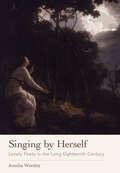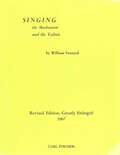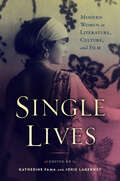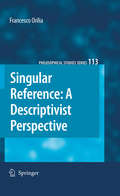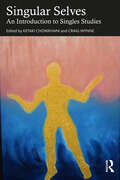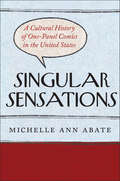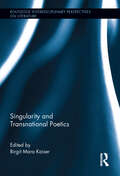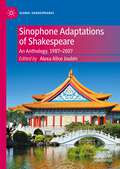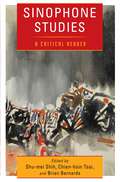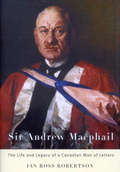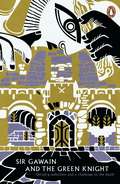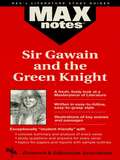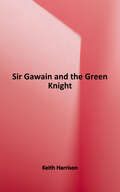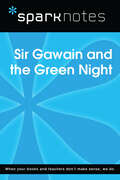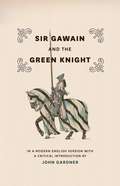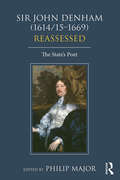- Table View
- List View
Singing by Herself: Lonely Poets in the Long Eighteenth Century
by Amelia WorsleySinging by Herself reinterprets the rise of literary loneliness by foregrounding the female and feminized figures who have been overlooked in previous histories of solitude. Many of the earliest records of the terms "lonely" and "loneliness" in British literature describe solitaries whose songs positioned them within the tradition of female complaint. Amelia Worsley shows how these feminized solitaries, for whom loneliness was both a space of danger and a space of productive retreat, helped to make loneliness attractive to future lonely poets, despite the sense of suspicion it evoked. Although loneliness today is often associated with states of atomized interiority, soliloquy, and self-enclosure, this study of eighteenth-century poetry disrupts the presumed association between isolation, singular speech, and bounded models of poetic subjectivity. In five chapters focused on lonely poet figures in the works of John Milton, Anne Finch, Alexander Pope, Thomas Gray, and Charlotte Smith—which also take account of the wider eighteenth-century fascination with literary loneliness—Singing by Herself shows how poets increasingly associated the new literary mode of being alone with states of disembodiment, dispersal, and echoic self-doubling. Seemingly solitary lonely voices often dissolve into polyvocal, allusive community, Worsley argues, when in dialogue with each other and also with classical figures of feminized lament such as Sappho, Echo, and Philomela.The book's provocative reflections on lyric mean that it will have a broad appeal to scholars interested in the history of poetry and poetics, as well as to those who study the literary history of gender, affect, and emotion.
Singing for Mrs. Pettigrew: Stories and Essays from a Writing Life
by Michael MorpurgoEvery writer's way to becoming a writer is unique, I am sure, though perhaps we all have much more in common than we believe. My way will not be the only way, but it is my way, and I hope it might be interesting and maybe even useful and encouraging to tell the story of how I became the writer I am.
Singing the News: Ballads in Mid-Tudor England (Material Readings in Early Modern Culture)
by Jenni HydeSinging the News is the first study to concentrate on sixteenth-century ballads, when there was no regular and reliable alternative means of finding out news and information. It is a highly readable and accessible account of the important role played by ballads in spreading news during a period when discussing politics was treason. The study provides a new analytical framework for understanding the ways in which balladeers spread their messages to the masses. Jenni Hyde focusses on the melody as much as the words, showing how music helped to shape the understanding of texts. Music provided an emotive soundtrack to words which helped to shape sixteenth-century understandings of gendered monarchy, heresy and the social cohesion of the commonwealth. By combining the study of ballads in manuscript and print with sources such as letters and state records, the study shows that when their topics edged too close to sedition, balladeers were more than capable of using sophisticated methods to disguise their true meaning in order to safeguard themselves and their audience, and above all to ensure that their news hit home.
Singing: The Mechanism and the Technic
by William VennardThis mechanistic book is an attempt to compile under one cover objective findings from various reliable sources and to relate them to the art of singing. There are those teachers who feel that applying science to an art is quackery, but some believe that our only safeguard against the charlatan is general knowledge of the most accurate information available. Whether you are a singer or a teacher of singing, you will find something to profitably add to your philosophy. This edition includes much more exact information.
Single Lives: Modern Women in Literature, Culture, and Film
by Kristin Celello Pamela Robertson Wojcik Benjamin Kahan Emma Liggins Ann Mattis Jorie Lagerwey Katherine Fama Andreá N. Williams Jennifer S. Clark Elizabeth DeWolfe Martina Mastandrea Ursula KaniaSingle Lives is a collection of singleness studies essays from the interdisciplinary humanities that explores the last two hundred years of literature and popular media by, about, and for single women in the US and the UK. Independent women have always been a center around which social anxieties and excitement coalesced. Moving between the family home and domestic independence, between household and public labor, and between celibacy and a range of sexual relations, the single woman remains a literary and cultural focus, as she has been from the 19th to the 21st centuries. This collection offers readers the opportunity to uncover the social, political, economic, and cultural connections between the "singly blessed" women and "bachelor girls" of the 19th and early 20th century and "all the single ladies" of the 21st century. Essays read singleness across genre and field, offering new approaches to studying modern and contemporary single women in literature, film, and history. Authors engage scholarship from wide ranging fields of social history, women's studies, queer theory, and Black feminism. The collection reads familiar texts against the grain, rethinking archival resources, revisiting familiar figures, and exploring new sources: cookbooks, ephemera, personal documents, recovered film histories, and forms of domestic space and labor.This is a book for scholars of gender and sexuality, social history, feminist film and media scholars, and literary historians, and reflects the urgent contemporary interest in single women as a political, economic, and cultural force.
Singular Pasts: The "I" in Historiography
by Enzo TraversoToday, history is increasingly written in the first person. A growing number of historical works include an autobiographical dimension, as if writing about the past required exploring the inner life of the author. Neither traditional history nor autobiography, this hybrid genre calls the norms of the historical profession into question. In search of new and creative paths, it transgresses a cardinal rule of the discipline: third-person narration, long considered necessary to the objective analysis of the past.Singular Pasts offers a critical account of the emergence of authorial subjectivity in historical writing, scrutinizing both its achievements and its shortcomings. Enzo Traverso considers a group of contemporary historians, including Ivan Jablonka, Sergio Luzzatto, and Mark Mazower, who reveal their emotional ties to their subjects and give their writing a literary flavor. He identifies a parallel trend in literature, in which authors such as W. G. Sebald, Patrick Modiano, Javier Cercas, and Daniel Mendelsohn write their works as investigations based on archival sources. Traverso argues that first-person history mirrors contemporary ways of thinking: such writing is presentist and apolitical, perceiving and representing the past through an individual lens. Probing the limits of subjective historiography, he emphasizes that it is collective action that produces social change: “we” instead of “I.” In an epilogue, Traverso considers the first-person writing of Saidiya Hartman as a counterexample. A wide-ranging and illuminating critique of a key trend in humanistic inquiry, Singular Pasts reconsiders the notion of historical truth in a neoliberal age.
Singular Reference: A Descriptivist Perspective
by Francesco OriliaSingular reference is the relation that a singular term has to a corresponding individual. For example, "Obama" singularly refer to the current US president. Descriptivism holds that all singular terms refer by means of a concept associated to the term. The current trend is against this. This book explains in detail (mainly for newcomers) why anti-descriptivism became dominant in spite of its weaknesses and (for experts) how these weaknesses can be overcome by appropriately reviving descriptivism.
Singular Selves: An Introduction to Singles Studies
by Ketaki Chowkhani and Craig WynneThis book examines, for perhaps the first time, singlehood at the intersections of race, media, language, culture, literature, space, health, and life satisfaction. It adopts an interdisciplinary approach, borrowing from sociology, literary studies, medical humanities, race studies, linguistics, demographic studies, and critical geography to understand singlehood in the world today. This collection of essays aims to establish the discipline of Singles Studies, finding new ways of examining it from various disciplinary and cultural perspectives. It begins with laying the field and then moves on to critically look at how race has shaped the way we understand singlehood in the West and how class, age, gender, privilege, and the media play a role in shaping singlehood. It argues for a need for increased interdisciplinarity within the field, for example, analyzing singlehood from the perspective of medical humanities. The volume also explores the role workplace, living arrangements, financial status, and gender play in single people’s life satisfaction. With an interdisciplinary and transnational approach, this interdisciplinary volume seeks to establish Singles Studies as a truly global discipline. This pathbreaking volume would be of interest to students and researchers of sociology, literature, linguistics, media studies, and psychology.
Singular Sensations: A Cultural History of One-Panel Comics in the United States
by Michelle Ann AbateWhat do The Family Circus, Ziggy, and The Far Side have in common? They are all single-panel comics, a seemingly simple form that cartoonists have used in vastly different ways. Singular Sensations is the first book-length critical study to examine this important but long-neglected mode of cartoon art. Michelle Ann Abate provides an overview of how the American single-panel comic evolved, starting with Thomas Nast’s political cartoons and R.F. Outcault’s groundbreaking Yellow Kid series in the nineteenth century. In subsequent chapters, she explores everything from wry New Yorker cartoons to zany twenty-first-century comics like Bizarro. Offering an important corrective to the canonical definition of comics as “sequential art,” Abate reveals the complexity, artistry, and influence of the single-panel art form. Engaging with a wide range of historical time periods, sociopolitical subjects, and aesthetic styles, Singular Sensations demonstrates how comics as we know and love them would not be the same without single-panel titles. Abate’s book brings the single-panel comic out of the margins and into the foreground.
Singularity and Transnational Poetics (Routledge Interdisciplinary Perspectives on Literature)
by Birgit Mara KaiserOver the past decade ‘singularity’ has been a prominent term in a broad range of fields, ranging from philosophy to literary and cultural studies to science and technology studies. This volume intervenes in this broad discussion of singularity and its various implications, proposing to explore the term for its specific potential in the study of literature. Singularity and Transnational Poetics brings together scholars working in the fields of literary and cultural studies, translation studies, and transnational literatures. The volume’s central concern is to explore singularity as a conceptual tool for the comparative study of contemporary literatures beyond national frameworks, and by implication, as a tool to analyze human existence. Contributors explore how singularity might move our conceptions of cultural identity from prevailing frameworks of self/other toward the premises of being as ‘singular plural’. Through a close reading of transnational literatures from Ireland, Germany, the Netherlands, France, and South Africa, this collection offers a new approach to reading literature that will challenge a reader’s established notions of identity, individuality, communicability, and social cohesion.
Sink or Float?
by Siu Lee Doreen Gay KasselThe fun and excitement of English and Language Arts learning continues in Grade 2 of Reading Street. This comprehensive and dynamic curriculum for homeschooling is geared toward young children who have some foundational English and Language Arts knowledge and are ready to strengthen their skills. Comprised of engaging activities, challenging content and weekly quizzes, Reading Street: Grade 2 is the next step in your child's path toward becoming a lifelong learner and reader. As with all Reading Street products, the Grade 2 system is formatted to help students meet certain age-appropriate goals. After completing this English and Language Arts homeschool program, your child should be able to: Read and comprehend two-syllable words. Identify common prefixes (such as pre-, un-, or re-) and suffixes (such as -able, -ad and -er). Correct mistakes made when reading out loud. Read books with two or more chapters. Understand the structure of stores (i. e. beginning, middle and end). Start selecting reading materials based on his/her own interests. Identify the "who," "what," "when," "where," "why" and "how" of the text. While the goals of second Grade English and Language Arts are numerous, Reading Street will help you craft engrossing lessons. Your child will garner important English and Language Arts skills while completing a workbook, reading stories and poems, and taking assessments. Planning these lessons will be easier than ever, as all Reading Street systems are broken down into weekly Big Ideas. All the work your child does on a given week is formulated around that single concept for an organized and challenging curriculum. With six easy-to-follow units, Reading Street: Grade 2 is the perfect tool for homeschooling parents. Your child will enjoy the reading selections and activities, and you'll love to see your student growing into a knowledgeable individual. We're confident that this product is the right one for you. For more information on the specific materials found in Grade 2 of Reading Street, check out the Features and Benefits page.
Sinophone Adaptations of Shakespeare: An Anthology, 1987-2007 (Global Shakespeares)
by Alexa Alice JoubinShakespeare’s tragedies have been performed in the Sinophone world for over two centuries. Hamlet, Macbeth, and King Lear are three of the most frequently adapted plays. They have been re-imagined as political theatre, comedic parody, Chinese opera, avant-garde theatre, and experimental theatre in Hong Kong, China, and Taiwan. This ground-breaking anthology features the first English translations of seven influential adaptations from 1987 to 2007 across a number of traditional and modern performance genres in Beijing, Shanghai, Hong Kong, and Taipei. Each of the book's three sections offers a pair of two contrasting versions of each tragedy - in two distinct genres - for comparative analysis. This anthology is an indispensable tool for the teaching and research of Sinophone theatre's engagement with Western classics in the late twentieth and early twenty-first centuries.
Sinophone Studies: A Critical Reader (Global Chinese Culture)
by Shih, Shu-Mei, Tsai, Chien-Hsin, and Bernards, Brian, eds.This definitive anthology casts Sinophone studies as the study of Sinitic-language cultures born of colonial and postcolonial influences. Essays by such authors as Rey Chow, Ha Jin, Leo Ou-fan Lee, Ien Ang, Wei-ming Tu, and David Wang address debates concerning the nature of Chineseness while introducing readers to essential readings in Tibetan, Malaysian, Taiwanese, French, Caribbean, and American Sinophone literatures. By placing Sinophone cultures at the crossroads of multiple empires, this anthology richly demonstrates the transformative power of multiculturalism and multilingualism, and by examining the place-based cultural and social practices of Sinitic-language communities in their historical contexts beyond "China proper," it effectively refutes the diasporic framework. It is an invaluable companion for courses in Asian, postcolonial, empire, and ethnic studies, as well as world and comparative literature.
Sins of the Fathers
by Hilaire KallendorfSins of the Fathers considers sins as nodes of cultural anxiety and explores the tensions between competing organizational categories for moral thought and behaviours, namely the Seven Deadly Sins and the Ten Commandments. Hilaire Kallendorf explores the decline and rise of these organizational categories against critical transformations of the early modern period, such as the accession of Spain to a position of world dominance and the arrival of a new courtly culture to replace an old warrior ethos. This ground-breaking study is the first to consider Spanish Golden Age comedias as an archive of moral knowledge. Kallendorf has examined over 800 of these plays to illustrate how they provide insight into aspects of early modern experience such as food, sex, work, and money. Finally, Kallendorf engages the theoretical terminology of Marxist literary criticism to demonstrate the inherent ambiguity of cultural change.
Sintaxis del español / The Routledge Handbook of Spanish Syntax (Routledge Spanish Language Handbooks)
by Rena Torres Cacoullos Guillermo Rojo Victoria Vázquez RozasEl volumen Sintaxis del español/The Routledge Handbook of Spanish Syntax proporciona una visión general de los temas fundamentales de la sintaxis del español, basada en datos extraídos de corpus textuales, sensible a los fenómenos de variación y conectada con otros componentes de la lengua. La obra, escrita en español, reúne perspectivas teóricas diversas, elaboradas por un grupo internacional de lingüistas. Está dividida en seis partes y comprende 45 capítulos centrados en cuestiones teóricas, cláusulas, oraciones y estructuras supraoracionales, categorías verbales, frases y clases de palabras, variación y cambio sintácticos, así como acercamientos computacionales y sus diferentes aplicaciones. El volumen constituye una referencia fundamental para los investigadores al tiempo que proporciona una introducción accesible para estudiantes de la lengua y la lingüística españolas. Sintaxis del español / The Routledge Handbook of Spanish Syntax provides a comprehensive overview of topics in Spanish syntax, drawing on corpus-based data, incorporating variation, and connecting with other aspects of language. Written in Spanish, the volume brings together diverse theoretical perspectives from an international group of scholars. Divided into six parts, the book comprises 45 chapters on theoretical perspectives, clauses, sentences and (supra)sentential syntax, verb categories, phrases and word classes, syntactic variation and change, and computational approaches and their applications. This handbook is an essential reference for scholars and an accessible introduction for students of Spanish language and linguistics.
Sir Andrew Macphail
by Ian Ross RobertsonMacphail's writing - characterized by clarity of expression and support for unpopular positions - allowed him to develop and document many of the important political, social, and intellectual themes of his time. He argued for the reorganization of the British Empire to reflect the growing importance of Canada and against such modern trends and movements as utilitarian education, feminism, industrialization, and urbanization. A strong advocate for the rejuvenation of rural life, he carried out agricultural experiments on his native Prince Edward Island. When it became apparent that it was impossible to return to rural ideals, Macphail celebrated the world of his rural past in his most memorable work - the posthumously published The Master's Wife.
Sir Andrew Macphail: The Life and Legacy of a Canadian Man of Letters
by Ian Ross RobertsonMacphail's writing - characterized by clarity of expression and support for unpopular positions - allowed him to develop and document many of the important political, social, and intellectual themes of his time. He argued for the reorganization of the British Empire to reflect the growing importance of Canada and against such modern trends and movements as utilitarian education, feminism, industrialization, and urbanization. A strong advocate for the rejuvenation of rural life, he carried out agricultural experiments on his native Prince Edward Island. When it became apparent that it was impossible to return to rural ideals, Macphail celebrated the world of his rural past in his most memorable work - the posthumously published The Master's Wife.
Sir Charles God Damn: The Life of Sir Charles G.D.Roberts
by John Coldwell AdamsA new era in Canadian poetry began in 1880 with the publication of Charles G.D. Roberts' Orion and Other Poems. He was just twenty years old. Roberts was soon acknowledged as leader of the so-called Confederation Poets--Bliss Carman, Duncan Campbell Scott, and Archibald Lampman. During his long lifetime he wrote hundreds of poems as well as novels, histories, short stories, translations, and essays; he also originated the realistic animal story popularized by Ernest Thompson Seton. He awed literary critics with the versatility of his writing and shocked staid Canadians with the escapades of an unconventional private life. Married at twenty in his native New Brunswick, Roberts soon after began a series of romantic entanglements. While his wife, May, raised the children in Fredericton, he swanned around New York, Havana, and the capitals of Europe. He experienced the Bohemian life of Washington Square around the turn of the century and lived in Montparnasse long before it became famous as an expatriate haven. In 1907 he sailed off to Europe and stayed for eighteen years. When he finally returned aboard the Berengaria in 1925 for a reading tour, he was lionized from coast to coast. For almost two decades he remained a prominent figure in Canadian literary and social circles. He was national president of the Canadian Authors' Association from 1927 to 1929, and in 1935 he was knighted. At the age of eighty-three, just three weeks before his death in 1943, he married for a second time. Perhaps over-praised as a writer in his own lifetime, Roberts' reputation has since languished. His main literary achievement, Adams concludes, was in being the first Canadian writer to come to terms with the Canadian landscape, influencing his contemporaries to see their own surroundings with fresh and discerning eyes. The story of his personal life, recounted here fully and objectively for the first time, adds a vivid portrait to the gallery of Canada's literary pioneers.
Sir Gawain and the Green Knight
by Burton RaffelDuring a Christmas feast at Camelot, King Arthur and his knights are interrupted by a monstrous green-skinned knight who offers them a simple but deadly challenge. Sir Gawain accepts this challenge, which will force him to choose between his honor and his life. Written by an unknown 14th century poet, this beloved tale is translated from the Old English.
Sir Gawain and the Green Knight (Legends from the Ancient North)
by Petra Borner'Tomorrow I must set off to receive that blow, to seek out that creature in green, God help me!'J.R.R. Tolkien spent much of his life studying, translating and teaching the great epic stories of northern Europe, filled with heroes, dragons, trolls, dwarves and magic. He was hugely influential for his advocacy of Beowulf as a great work of literature and, even if he had never written The Hobbit and The Lord of the Rings, would be recognised today as a significant figure in the rediscovery of these extraordinary tales.Legends from the Ancient North brings together from Penguin Classics five of the key works behind Tolkien's fiction.They are startling, brutal, strange pieces of writing, with an elemental power brilliantly preserved in these translations.They plunge the reader into a world of treachery, quests, chivalry, trials of strength.They are the most ancient narratives that exist from northern Europe and bring us as near as we will ever get to the origins of the magical landscape of Middle-earth (Midgard) which Tolkien remade in the 20th century.
Sir Gawain and the Green Knight (Maxnotes Literature Guides)
by Boria SaxREA's MAXnotes for The Gawain Poet's Sir Gawain and the Green Knight MAXnotes offer a fresh look at masterpieces of literature, presented in a lively and interesting fashion. Written by literary experts who currently teach the subject, MAXnotes will enhance your understanding and enjoyment of the work. MAXnotes are designed to stimulate independent thought about the literary work by raising various issues and thought-provoking ideas and questions. MAXnotes cover the essentials of what one should know about each work, including an overall summary, character lists, an explanation and discussion of the plot, the work's historical context, illustrations to convey the mood of the work, and a biography of the author. Each section of the work is individually summarized and analyzed, and has study questions and answers.
Sir Gawain and the Green Knight (Oxford World's Classics)
by Keith HarrisonThis text with its intricate plot of enchantment and betrayal is probably the most skilfully told story in the whole of the English Arthurian cycle. Originating from the northwest midlands of England, it is based on two separate and very ancient Celtic motifs of the Beheading and the Exchange of Winnings, brought together by the anonymous 14th-century poet. His telling comprehends a great variety of moods and modes - from the stark realism of the hunt scenes to the delicious and dangerous bedroom encounters between Lady Bercilak and Gawain, from moments of pure lyric beauty when he evokes the English countryside in all its seasons, to authorial asides that are full of irony and puckish humour. This new verse translation uses a modern alliterative pattern that subtly echoes the music of the original at the same time as it strives for fidelity.
Sir Gawain and the Green Knight (SparkNotes Literature Guide Series)
by SparkNotesSir Gawain and the Green Knight (SparkNotes Literature Guide) Making the reading experience fun! Created by Harvard students for students everywhere, SparkNotes is a new breed of study guide: smarter, better, faster. Geared to what today's students need to know, SparkNotes provides: *Chapter-by-chapter analysis *Explanations of key themes, motifs, and symbols *A review quiz and essay topicsLively and accessible, these guides are perfect for late-night studying and writing papers
Sir Gawain and the Green Knight: In a Modern English Version
by John GardnerThe adventures and challenges of Sir Gawain, King Arthur's nephew and a knight at the Round Table, including his duel with the mysterious Green Knight, are among the oldest and best known of Arthurian stories. Here the distinguished author and poet John Gardner has captured the humor, elegance, and richness of the original Middle English in flowing modern verse translations of this literary masterpiece. Besides the tale of Sir Gawain and the Green Knight, this edition includes two allegorical poems, "Purity" and "Patience"; the beautiful dream allegory "Pearl"; and the miracle story "Saint Erkenwald," all attributed to the same anonymous poet, a contemporary of Chaucer and an artist of the first rank. "Mr. Gardner has translated into modern English and edited a text of these five poems that could hardly be improved. . . . The entire work is preceded by a very fine and complete general introduction and a critical commentary on each poem. "--Library Journal
Sir John Denham (1614/15–1669) Reassessed: The State's Poet
by Philip MajorSir John Denham (1614/15–1669) Reassessed shines new light on a singular, colourful yet elusive figure of seventeenth-century English letters. Despite his influence as a poet, wit, courtier, exile, politician and surveyor of the king's works, Denham, remains a neglected figure. The original essays in this interdisciplinary collection provide the sustained modern critical attention his life and work merit. The book both examines for the first time and reassesses important features of Denham's life and reputations: his friendship circles, his role as a political satirist, his religious inclinations, his playwriting years, and the personal, political and literary repercussions of his long exile; and offers fresh interpretations of his poetic magnum opus, Coopers Hill. Building on the recent resurgence of scholarly interest in royalists and royalism, as well as on Restoration literature and drama, this lively account of Denham's influence questions assumptions about neatly demarcated seventeenth-century chronological, geographic and literary boundaries. What emerges is a complex man who subverts as well as reinforces conventional characterisations of court wit, gambler and dilettante.
